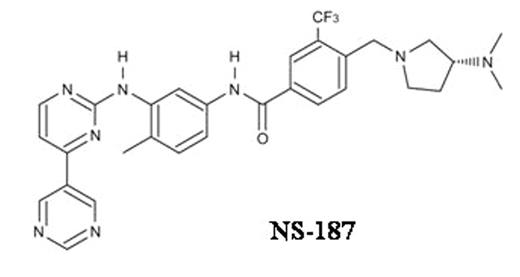Abstract
Chemical modifications of imatinib mesylate made with the guidance of molecular modeling yielded several promising compounds. Among them, we selected a compound denoted NS-187 (elsewhere described as CNS-9) on the basis of its affinity to Abl, and also to Lyn, which may be involved in imatinib-resistance (Figure). The most striking structural characteristic of NS-187 is its trifluoromethyl (CF3) group at position 3 of the benzamide ring. The presence of the CF3 group strengthened the hydrophobic interactionss of the molecule with the hydrophobic pocket of Abl. Another possible merit of the CF3 group is that it may fix the conformation of the drug by hindering its rotation at the 4-position of the benzamide ring; as a result, a CF3-bearing molecule may be more potent than more flexible compounds such as imatinib. In fact, NS-187 was 25–55 times more potent than imatinib in vitro and and at least 10 times more potent than in vivo. NS-187 also inhibited the phosphorylation and growth of all Bcr-Abl mutants tested except T315I at physiological concentrations. Another special feature of NS-187, in addition to its increased affinity to Abl is its unique spectrum of inhibitory activity against protein kinases. At a concentration of 0.1 μM, NS-187 inhibited only four of 79 tyrosine kinases, that is, Abl, Arg, Fyn, and Lyn. Notably, at 0.1 μM NS-187 did not inhibit PDGFR, Blk, Src or Yes. The IC50 values of NS-187 for Abl, Src and Lyn were 5.8 nM, 1700 nM and 19 nM, respectively, and those of imatinib were 106 nM, >10,000 nM and 352 nM, respectively. These findings indicate that NS-187 acts as a Bcr-Abl/Lyn inhibitor. In this respect, NS-187 may stand out among other novel Abl tyrosine kinase inhibitors, because BMS-354825 inhibits all members of the Src family, while AMN-107 inhibits none of the Src-family kinases. Our proposed docking models of the NS-187/Abl complex support the notion that NS-187 is more specific for Lyn than for Src. The amino acid at position 252 is either Gln or Cys in Src-family proteins. NS-187 inhibited the Gln252-bearing proteins Abl, Fyn and Lyn but had lower activity against the Cys252-bearing Src and Yes. This is probably because Gln, unlike Cys, readily forms hydrogen bonds. The distinguishing characteristic of NS-187, its high affinity for and specific inhibition of Abl and Lyn, may be useful in the treatment of Bcr-Abl-positive leukemia patients.
Author notes
Corresponding author


This feature is available to Subscribers Only
Sign In or Create an Account Close Modal